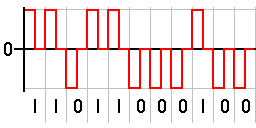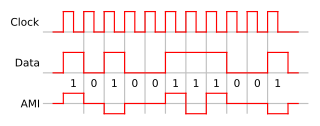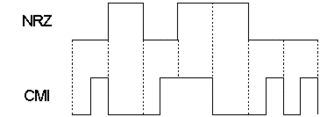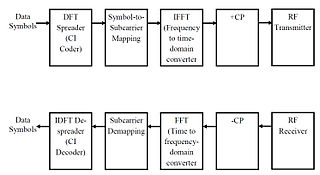
Code-division multiple access (CDMA) is a channel access method used by various radio communication technologies. CDMA is an example of multiple access, where several transmitters can send information simultaneously over a single communication channel. This allows several users to share a band of frequencies. To permit this without undue interference between the users, CDMA employs spread spectrum technology and a special coding scheme.

In telecommunications, orthogonal frequency-division multiplexing (OFDM) is a type of digital transmission used in digital modulation for encoding digital (binary) data on multiple carrier frequencies. OFDM has developed into a popular scheme for wideband digital communication, used in applications such as digital television and audio broadcasting, DSL internet access, wireless networks, power line networks, and 4G/5G mobile communications.
Differential Manchester encoding (DM) is a line code in digital frequency modulation in which data and clock signals are combined to form a single two-level self-synchronizing data stream. Each data bit is encoded by a presence or absence of signal level transition in the middle of the bit period, followed by the mandatory level transition at the beginning. The code is insensitive to an inversion of polarity. In various specific applications, this method is also called by various other names, including biphase mark code (CC), F2F, Aiken biphase, and conditioned diphase.

In telecommunication, a line code is a pattern of voltage, current, or photons used to represent digital data transmitted down a communication channel or written to a storage medium. This repertoire of signals is usually called a constrained code in data storage systems. Some signals are more prone to error than others as the physics of the communication channel or storage medium constrains the repertoire of signals that can be used reliably.
In telecommunication and data storage, Manchester code is a line code in which the encoding of each data bit is either low then high, or high then low, for equal time. It is a self-clocking signal with no DC component. Consequently, electrical connections using a Manchester code are easily galvanically isolated.

In telecommunication, a non-return-to-zero (NRZ) line code is a binary code in which ones are represented by one significant condition, usually a positive voltage, while zeros are represented by some other significant condition, usually a negative voltage, with no other neutral or rest condition.
In telecommunication, a ternary signal is a signal that can assume, at any given instant, one of three states or significant conditions, such as power level, phase position, pulse duration, or frequency.
In telecommunications, a transmission system is a system that transmits a signal from one place to another. The signal can be an electrical, optical or radio signal. The goal of a transmission system is to transmit data accurately and efficiently from point A to point B over a distance, using a variety of technologies such as copper cable and fiber-optic cables, satellite links, and wireless communication technologies.
Pulse-position modulation (PPM) is a form of signal modulation in which M message bits are encoded by transmitting a single pulse in one of possible required time shifts. This is repeated every T seconds, such that the transmitted bit rate is bits per second. It is primarily useful for optical communications systems, which tend to have little or no multipath interference.

Coding theory is the study of the properties of codes and their respective fitness for specific applications. Codes are used for data compression, cryptography, error detection and correction, data transmission and data storage. Codes are studied by various scientific disciplines—such as information theory, electrical engineering, mathematics, linguistics, and computer science—for the purpose of designing efficient and reliable data transmission methods. This typically involves the removal of redundancy and the correction or detection of errors in the transmitted data.

Return-to-zero describes a line code used in telecommunications signals in which the signal drops (returns) to zero between each pulse. This takes place even if a number of consecutive 0s or 1s occur in the signal. The signal is self-clocking. This means that a separate clock does not need to be sent alongside the signal, but suffers from using twice the bandwidth to achieve the same data-rate as compared to non-return-to-zero format.
Run-length limited or RLL coding is a line coding technique that is used to send arbitrary data over a communications channel with bandwidth limits. RLL codes are defined by four main parameters: m, n, d, k. The first two, m/n, refer to the rate of the code, while the remaining two specify the minimal d and maximal k number of zeroes between consecutive ones. This is used in both telecommunication and storage systems that move a medium past a fixed recording head.
On–off keying (OOK) denotes the simplest form of amplitude-shift keying (ASK) modulation that represents digital data as the presence or absence of a carrier wave. In its simplest form, the presence of a carrier for a specific duration represents a binary one, while its absence for the same duration represents a binary zero. Some more sophisticated schemes vary these durations to convey additional information. It is analogous to unipolar encoding line code.

In telecommunication, bipolar encoding is a type of return-to-zero (RZ) line code, where two nonzero values are used, so that the three values are +, −, and zero. Such a signal is called a duobinary signal. Standard bipolar encodings are designed to be DC-balanced, spending equal amounts of time in the + and − states.

IEEE Standard 1355-1995, IEC 14575, or ISO 14575 is a data communications standard for Heterogeneous Interconnect (HIC).

In telecommunication, coded mark inversion (CMI) is a non-return-to-zero (NRZ) line code. It encodes zero bits as a half bit time of zero followed by a half bit time of one, and while one bits are encoded as a full bit time of a constant level. The level used for one bits alternates each time one is coded.
In telecommunications, the hybrid (H-) ternary line code is a line code that operates on a hybrid principle combining the binary non-return-to-zero-level (NRZL) and the polar return-to-zero (RZ) codes.

Carrier Interferometry(CI) is a spread spectrum scheme designed to be used in an Orthogonal Frequency-Division Multiplexing (OFDM) communication system for multiplexing and multiple access, enabling the system to support multiple users at the same time over the same frequency band.
Pulse-code modulation (PCM) is a method used to digitally represent sampled analog signals. It is the standard form of digital audio in computers, compact discs, digital telephony and other digital audio applications. In a PCM stream, the amplitude of the analog signal is sampled at uniform intervals, and each sample is quantized to the nearest value within a range of digital steps.

A digital signal is a signal that represents data as a sequence of discrete values; at any given time it can only take on, at most, one of a finite number of values. This contrasts with an analog signal, which represents continuous values; at any given time it represents a real number within a continuous range of values.










